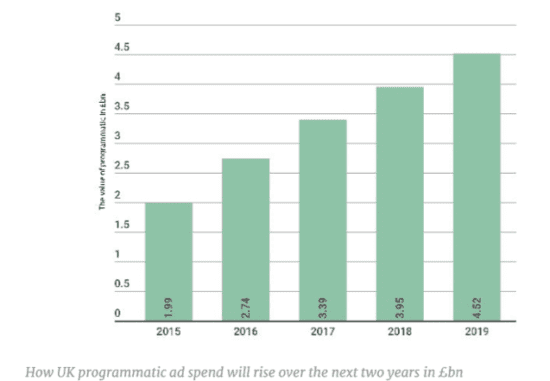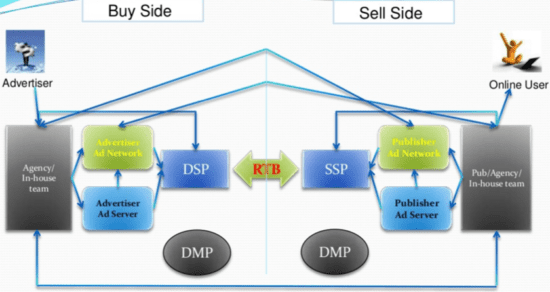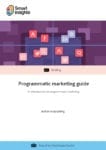How programmatic marketing can help you target specific demographics
Over the last five years, the way advertisers have bought media and the way publishers have sold it has changed significantly. Influenced by technology, sophisticated platforms, and automated processes, advertisers have the ability to target groups in real-time, through a range of segmentation methods and demographics.
In theory, this new way of buying should bring marketers and media planners closer together. With the new level of transparency, it’s surprising how many marketers still do not understand the programmatic media buying process.
Programmatic marketing guide
This report is aimed at marketing managers and directors, digital marketing, and e-commerce managers who are looking to understand the key components of programmatic marketing from both an agency and advertiser perspective.
Access the Programmatic marketing guide quick win
According to eMarketer, the total UK spend on programmatic advertising is expected to more than double from £1.99 billion in 2015 to £4.52 billion by 2019. This will account, on average, for 80% of digital media brought programmatically.

A data-led approach
The key ingredient to successful targeting is data. The greater the opt-in insight an advertiser has on its audience, the greater the level of targeting and the more likely the campaign will meet business goals and objectives. There are three types of data advertiser and marketers need to know:
First-party data
This is the most powerful data of all – data collected directly from your customers (this could be from websites and registration forms). It’s, therefore, the most relevant and accurate, providing a more accurate picture of the target audience.
Second-party data
This is a relatively new form of data collection. Essentially, it is another company’s first-party data that is collected and sold to an advertiser. For example, a high street retailer may sell its loyalty card data to an FMCG organization who doesn’t have a direct to consumer proposition and relies on distribution networks both on and offline to sell its products and services.
Third-party data
This is standard data that you can buy pre-collected from an external source. If you receive an email from a company you’ve never heard of, it’s very likely your data has been sold. This source of data will be heavily impacted by the General Data Protection Regulation (GDPR), where heavy fines are issued for non-opt-in communication.
Programmatic platforms
As already mentioned, the platforms that make up the programmatic process enable advertisers and publishers to trade through technology, removing the need for human intervention and enabling marketers to deliver highly-targeted campaigns in real-time, with the chance to optimize during the campaign.
The buy/sell ad model

Demand-side platforms (DSPs)
A demand-side platform is a piece of software used to purchase advertising in an automated fashion. DSPs are most often used by advertisers and agencies to help them buy display, video, mobile, and search ads. They help make that process cheaper and more efficient by removing humans from parts of the process, as well as the need to negotiate ad rates and to manually send ad insertion orders.
Real-time bidding
Real-time bidding is often confused for being programmatic. Of course, it is part of a wider process, essentially it is the buying and selling of online ad impressions using real-time auctions that appear in the time it takes a webpage to load. Those auctions are often facilitated by ad exchanges or supply-side platforms.
Supply-side platforms (SSPs)
A supply-side platform is software used to sell advertising in an automated fashion. SSPs are most often used by online publishers to help them sell display, video, and mobile ads.
An SSP is the publisher equivalent of a DSP. SSPs are designed by publishers to do the opposite, i.e maximize the prices their impressions sell at.
Data management platforms (DMPs)
A DMP is a data warehouse. It’s a piece of software that sucks up, sorts, and houses information in a way that’s useful for marketers, publishers, and other businesses.
They can help tie all that activity and resulting campaign and audience data together in one, centralized location and use it to help optimize future media buys/ad creative. It’s all about better understanding customer information.

Ad fraud
There are many reasons to invest in programmatic, so marketers need to understand the potential impact of ad-fraud on their budgets. Put very simply, real people may not view the advertisers’ creative, therefore the campaign performance will be misrepresented and marketers will be forced to make wrong decisions – pulling creative or, even worse, media to try and hit a number.
The common types of fraud can be seen below:
Site bundling
In the RTB ecosystem, inventory is classified by site ID and each site ID is supposed to correlate to a single domain. Many publishers and ad exchanges bundle entire networks/websites of domains under a single site ID. This means an advertiser might think they are buying traffic on a premium site, but they actually end up with ads served on a completely different site, which could conflict with the brand.
Arbitrage
This can take many forms and impact various formats, including display and video. Basically, fraudulent publishers purchase traffic for a super-low cost and resell it for a multiple of the price. For example, a publisher may sell its inventory for £3 CPM on average, but could well be purchasing suspect traffic to its site for a tiny fraction of the cost.
Botnets
Botnets are a large array of personal computers that have been compromised by fraudulent users. The fraudster completely control of these devices, programming them to load and click on ads, which generates legitimate-looking, but completely fake, impressions and clicks for advertisers.
Compliance
The greatest change in the last four years to impact digital marketing and programmatic is the General Data Protection Regulation, which came into force on 25th May 2018.
The GDPR impacts all companies that control or process personal data of EU citizens, even if the company is not located in the EU. The legislation influences how marketers can obtain, manage, and process such personal data.
Marketers will have to shift their efforts to focus on segments. For example, marketers could advertise to women who live in London, shop at Selfridges and buy coffee at Starbucks, since there thousands of women who fit that description. Under GDPR, they couldn’t legally add filters so specific that the target audience is narrowed down to an individual woman without explicit end-user permissions.
In summary
Programmatic is a media buying approach for better-removing ambiguity, bringing all the key stakeholders of the process closer together and, more importantly, closer to the customer. That said, it is crucial for marketers to understand the process and the potential challenges in ad fraud and changes in the law with GDPR.










